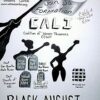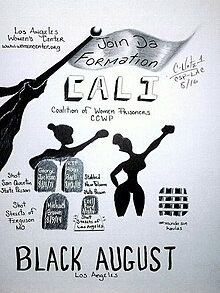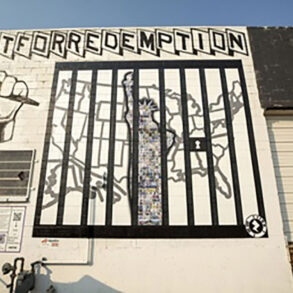
Donald “C-Note” Hooker is an artist who has been dubbed the “Black August Artist,” due to his role in the Black August Movement.
The Black August Movement is a collective of African Americans who are striving for freedom, justice, and equality through the power of art, literature, music, and activism. This blog post will explore C-Note’s involvement in the Black August Movement and its significance to the community.
Who is Donald “C-Note” Hooker?

Donald “C-Note” Hooker is a name that has become synonymous with Black History, Black Art, and the fight for Black Liberation. As a prison artist, C-Note has dedicated his life and his art to the struggle for justice and equality for Black people. He has become a powerful voice for Black Freedom Fighters, using his music, poetry, plays, and art, to shed light on the realities faced by African Americans in the United States.
Orphaned at birth in Los Angeles, C-Note was exposed to the harsh realities of urban life from an early age. He witnessed the systemic racism and injustice that plagued his community, and he felt a deep sense of responsibility to use his talents to bring about change. Drawing inspiration from the Black artists who came before him, such as Nina Simone and James Baldwin, C-Note developed a unique artistic style that blends hip-hop, spoken word, and visual art.
Through his music, poetry, plays, performance art, and visual art, C-Note tackles pressing social issues such as mass incarceration, police brutality, and the legacy of slavery. His powerful lyrics and soul-stirring performances have earned him a dedicated following and have made him a prominent figure in the Black August Movement. He uses his platform to amplify the voices of those who are marginalized and to challenge the status quo.
C-Note’s art is not only a reflection of his personal experiences, but also a call to action. He believes in the power of art to inspire change and ignite conversations that can lead to collective healing. His visual and literary art serves as a reminder that the struggle for liberation is ongoing, and that each individual has a role to play in the fight for justice.
What is the Black August movement?

The Black August Movement, better known as Black August, is an annual commemoration and prison-based holiday to remember Black political prisoners, Black freedom struggles in the United States and beyond, and to highlight Black resistance against racial, colonial and imperialist oppression. It takes place during the entire calendar month of August.
Black August was initiated by the Black Guerilla Family in San Quentin State Prison in 1979 when a group of incarcerated people came together to commemorate the deaths of brothers Jonathan P. Jackson (d. August 7, 1970) and George Jackson (d. August 21, 1971) at San Quentin State Prison. The two brothers were both political activists and members of the Black Panther Party.
Black August is a time for reflection, study, and action. Participants may fast from food and drink, engage in physical exercise and political study, and participate in political struggle. The principles of Black August are: “study, fast, train, fight.”
Black August is a reminder of the long history of Black resistance to oppression and a call to continue the fight for liberation. It is a time to honor the sacrifices of those who have come before and have committed themselves to building a better future for all.
Here are some ways to participate in Black August:
* Learn about the history of Black political prisoners and the Black freedom struggle.
* Read the works of Black revolutionaries and activists.
* Attend events and demonstrations that commemorate Black August.
* Donate to organizations that support Black political prisoners.
* Get involved in your community and work to build a more just and equitable society.
Black August is a time to remember, to learn, and to act. It is a time to use the month of August to honor the legacy of those who have fought for freedom and to continue the struggle for a better future.
At the heart of the Black August Movement in the 21st century is Donald “C-Note” Hooker, a prison artist who has emerged as a vital voice in the fight for Black liberation. Black August as a month-long commemoration began in 1979, after the 1978 death of Khatari Gaulden, who was killed the year before on Aug. 1st, as a result of medical neglect by San Quentin Prison authorities. Instead of adding Aug. 1st, to the existing days of observation that marked the deaths of prison activists like W.L. Nolen, Alvin Miller, Cleveland Edwards, and George and Jonathan Jackson, the prisoners at San Quentin State Prison standing in resistance to the massive California prison-industrial complex, declared the whole month to be Black August.
These original forefathers to the Black August Movement have either passed on to be with their ancestors, too old to be physically responsible for themselves, or whose days on Earth are numbered due to their old age.
Prison artist C-Note represents the next generation to push the mantras of Black August behind the enemy lines of white supremacy’s late 20th century New Jim Crow of mass incarceration; where racial sentencing disparities have been prevalent across the various local, state, and federal, criminal justice systems.
C-Note’s unique perspective and artistic talent have allowed him to connect with people from all walks of life, transcending the barriers of confinement to make a significant impact on the movement.
The Black August Movement not only serves as a platform for artists like C-Note, but also as a community of like-minded individuals who are dedicated to promoting social justice and empowerment. By utilizing literary art, visual art, and music as a catalyst for change, this movement inspires collective action, encourages dialogue, and fosters a sense of solidarity among its members.
C-Note’s involvement in the Black August Movement exemplifies the transformative power of art and its ability to serve as a tool for social change. Through his work, he highlights the ongoing struggle for liberation and reminds us that the fight for justice is far from over. The Black August Movement continues to be a driving force in the fight against racial injustice, and artists like C-Note play a pivotal role in amplifying marginalized voices and creating spaces for collective healing and progress.
How did C-Note become involved in the Black August movement?

Donald “C-Note” Hooker’s journey into the Black August movement is a testament to his unwavering commitment to justice and equality. As a prison artist, C-Note’s passion for creating art that reflects the realities of African Americans in the United States led him to become an integral part of the movement.
His 2017 Paintoem (painting + poem), Strange Fruit, gave voice to the October 2016, edition of the San Quentin News, where it reported, “During an 18-month period in 2014 -15, the suicide rate at the California Institution for Women (C.I.W.), was eight times the national average for women prisoners and five times the rate for the entire California prison system.”

During the aftermath of the March 13th, 2020, Louisville, Kentucky, death of Breonna Taylor, C-Note re-purposed his original drawing Strange Fruit, to become a #SayHerName protest poster.

This poster has become very popular amongst grass roots activists.

C-Note’s involvement in the Black August movement began during his current stint in prison, where he received a Third Strike sentence of 35 years to Life for pulling out a knife on a homeless man. During this incarceration, C-Note discovered the transformative power of art and its ability to inspire change. In the confines of his cell, he turned to music, art, and literature, as a way to express his frustrations, fears, and hopes. Through his art, he found solace and a sense of purpose.
It was during this time that C-Note became fully aware of his obligation to the Black August movement and the important work it was doing to challenge systemic racism and promote social justice. He saw the movement as an opportunity to amplify his voice and contribute to the collective struggle for liberation.
C-Note’s art caught the attention of fellow activists and artists who were also involved in the Black August movement. They recognized his talent and the power of his message, and soon, C-Note found himself collaborating with like-minded individuals who shared his passion for using art as a tool for change.
Through his poetry, plays, performance art, and award winning visual art, C-Note addressed pressing social issues such as mass incarceration, police brutality, and the legacy of slavery. His powerful works and soul-stirring performances resonated with audiences and helped to ignite conversations about these important issues.

As C-Note continued to create and perform, his influence within the Black August movement grew. He became a symbol of resilience and strength, inspiring others to use their own artistic talents to contribute to the fight for justice.

C-Note’s involvement in the Black August movement is a testament to the transformative power of art and its ability to transcend the physical barriers of confinement.
The significance of C-Note’s poetry in the Black August movement

C-Note’s poetry holds immense significance within the Black August movement. As a prison artist, C-Note uses his poetry as a powerful tool to shed light on the struggles faced by African Americans in the United States.
One such memorable poem is Can’t Black Lives Matter Too???, a 7-minute work of performance poetry created for C-Note’s performance poetry finals with the California State University, San Bernardino’s, Prison Arts Collective’s inaugural 10-week performance poetry class.
C-Note created the poem because he was concerned about the Black Lives Matter phrase being co-opted by other groups.
C-Note argues that the Black Lives Matter movement is important because it acknowledges the collective tragedies of African-Americans. His poem points out that other groups, such as Italians, Mexicans, Chinese, Poles, and women, have also suffered tragedies. However, he argues that the Black Lives Matter movement is still important because it is specifically focused on the experiences of African-Americans.
The poem ends with the story of Recy Taylor, a 24-year-old African-American woman who was gang-raped by six Caucasian boys in 1944. Taylor’s story is a powerful example of the violence that African-Americans have faced throughout history.
C-Note’s poem is a powerful and thought-provoking piece of work that addresses important issues of race, violence, and social justice. It is a must-read or listen-to, for anyone who wants to understand the Black Lives Matter movement and its importance.
C-Note’s poetry is not only a reflection of his personal experiences, but it also serves as a voice for the marginalized and oppressed. Through his poetry, he addresses the harsh realities of mass incarceration, police brutality, and the enduring legacy of slavery. C-Note’s raw and unapologetic approach to storytelling allows listeners and readers to empathize with these experiences and to confront their own biases and preconceived notions.
In 2018, for the 30th Anniversary Year of the Celebration of African American Poets and Their Poetry, C-Note wrote the poem Journey to Afrofuturism. It was in response to one of the event’s poetry prompts, “400 Years of California African American History (1535-1872, slave state to now).” Journey to Afrofuturism was recited at the event.
Upon learning that the 30 years of the event would be compiled into a book, C-Note created a drawing to go along with his poem, and named the drawing Journey to Afrofuturism.

Both the poem and the artwork was published in Speculative City Magazine’s, 2020 Winter edition, #10, Afrofuturism. The poem received critical acclaim from JoAnne Tompkins, author of What Comes After, and Speculative fiction critic Charles Payseur of Quick Sip Reviews. Payseur wrote, “The poem to me feels like a celebration of scholarship and of art to reach back and make connections, to find afrofuturism waiting in all times, in all places, a feeling of connecting this work to a kind of collective past, one that recognizes Black excellence and endeavor, that shows that the West has never been only white. And for me the piece finds a lot of hope in that, of finding these buried roots that can still find their way to the surface and become new growth. There’s a sense that the piece could almost be saying something about the ‘true’ path of afrofuturism.”
In October of 2021, Journey to Afrofuturism received a recital and viewing, as it brought to a close, the University of California, Santa Cruz (UCSC), virtual event, “Afrofuturism Then and Now.” The event was the inaugural 2021 – 2022 Academic Year Global discussion and performances on what Afrofuturism means and how it manifests in cultural practices.
The recorded Zoom call panelists consisted of speakers in diverse locations such as the Congo in Central Africa, Burkina Faso in West Africa, and several cities in the Northern California Bay Area of the United States. The event concluded with Hip Hop artist and Hip Hop Congress Board Chairman, Rahman Jamaal exhibiting and reciting C-Note’s artwork and poem Journey to Afrofuturism.
For the 2023 Black History Month Celebrations, Journey to Afrofuturism was featured in the PR campaign, “The Announcement of the Other Woman King for Black History Month Celebrations.”

This Black History Month Celebrations’ campaign, told of the African conquest of Europe, and how the State of California was named after an African or Moorish Queen.
One of the reasons why C-Note’s poetry is so significant within the Black August movement is its ability to unite people from all walks of life. His poems serve as a rallying cry for justice and equality, transcending the boundaries of confinement and reaching audiences beyond prison walls.
One such poem is the 2003 epic poem, THE CRIMINALIZATION OF OUR AMERICAN CIVILIZATION (This Is Not A Manifesto).
In 2019, C-Note gave a spoken word rendition of the 700+ word epic poem at the California State Prison, Los Angeles County, for the theatrical performance of This Concrete Life.

This Concrete Life was a 1-day, 90-minute, solo and group theatrical performance by prisoners at the California State Prison, Los Angeles County, Facility B-yard. It was the accumulation of 16 weeks of theatrical training by the theatrical troupe Fugitive Kind Theater, a Los Angeles-based troupe committed to social justice by amplifying the voices of the incarcerated and returning citizens.
By sharing his lived experiences through his poetry, C-Note humanizes the struggles faced by African Americans and encourages empathy and understanding amongst readers and listeners.
Overall, C-Note poetry is not only a form of artistic expression, but it is also a powerful tool for social change. His poems resonate with listeners and readers on a profound level, challenging societal norms and advocating for justice and equality. Through his poetry, C-Note continues to leave a lasting impact on the Black August movement, reminding us all of the power of art to inspire, educate, and transform.
C-Note’s impact on contemporary activism

C-Note’s impact on contemporary activism cannot be overstated. As a prison artist, C-Note has managed to transcend the physical barriers of confinement and use his art as a powerful force for change. His poems, plays, performances, and visual art, have become a rallying cry for justice, inspiring countless individuals to join the fight for liberation.

In the realm of contemporary activism, C-Note has become an icon. His courage, resilience, and dedication to justice have earned him the admiration and respect of countless individuals. Through his art, he has managed to bring attention to important social issues, challenge the status quo, and inspire collective action.
C-Note’s impact on contemporary activism, his role as the Black August Artist, is a testament to the power of art as a tool for social change and a reminder that anyone, regardless of their circumstances, can make a meaningful impact on the fight for justice and equality.
This post was originally published on this site be sure to check out more of their content







